By Benjamin Phillips and Benjamin Werling et.al
The forecast calls for:
- Mostly sunny and warmer Thursday, May 11, in lower Michigan. Scattered showers possible upper Michigan.
- Mostly cloudy/partly sunny with showers possible Friday through Sunday in southern lower Michigan, with best chances for rainfall to the southwest. Fair and dry in most northern areas.
- Fair, dry and cooler on Monday, with scattered showers possible again Tuesday.
- High temperatures in the 70s Wednesday to the upper 70s to low 80s Thursday and Friday, falling back again to the 60s by Sunday. Low temperatures from the mid-40s to low 50s Thursday warming to the 50s by Friday through the weekend, then cooling to the 40s by early next week.
- Medium range guidance calls for a return of cooler than normal temperatures next week and the following week with normal to below normal precipitation totals.
Greenhouse transplants and viruses
Growers with vegetable transplants in the greenhouse should be looking for the subtle symptoms of viral pathogens, including impatiens necrotic spot virus (INSV). Symptoms on young plants in the greenhouse include necrosis along veins, mottling, bronzing and stunting. Impatiens necrotic spot virus has a very wide host range that includes many vegetables (tomato and pepper in particular) as well as ornamentals. Every year, we see INSV in vegetable transplants produced in greenhouses that were also being used to produce other types of plants.
Symptomatic plants should be tested, either with in-house tests or by a diagnostic lab. Infected plants must be removed and destroyed; plants with a viral disease cannot be “cured.” Other aspects of disease management include weed and insect control. Weeds growing in greenhouses can harbor viruses that can be spread to vegetable transplants. INSV and tomato spotted wilt virus (TSWV) are spread by flower thrip so insect management in the greenhouse is an important component of disease management.
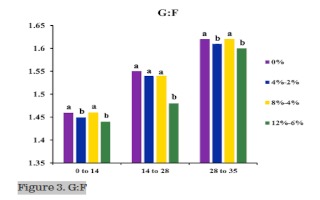

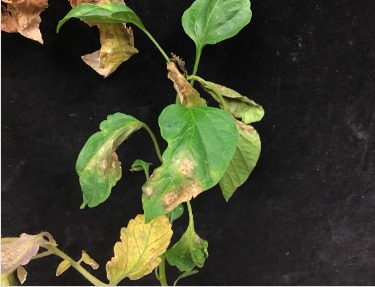
Root rots on vegetable plugs and transplants are also causing problems for some growers. Diagnosis is important for choosing appropriate management strategies, but not easily done in the greenhouse. Symptomatic plants should be sent to a diagnostic lab for analysis. Plants should be left in containers (plug trays, cell packs, or pots) for shipping to the lab. To simplify packing and shipping, consider cutting a section of the tray for submission.
Low tunnels in the field
Some growers use low tunnels made of fabric or clear plastic over young melon, watermelon, pepper, and tomato transplants this time of year to protect from potential frosts, but these installations do more than that. Planting warm season crops early doesn’t guarantee an early harvest if the weather remains cool, but adding the row covers increases temperatures under fabric cover by about 20 degrees on a sunny day and pushes plants to grow faster. Clear vented plastic can increase temperatures by up to 40 degrees Fahrenheit and should be used with caution and careful attention to sunny warm trends. As one grower put it, “I’ve killed more plants under plastic than under fabric.”
Crop updates
Asparagus
There were some good pickings over the weekend in southwest Michigan, with harvest starting Monday in west central.
Keep an eye out for asparagus beetle as harvest ramps up. This may be especially important given our mild winter. Insecticides with a one-day preharvest interval (PHI) include carbaryl (e.g., Carbaryl 4L) and acetamiprid (e.g., Assail). Lannate and permethrin are also labeled but may be less effective.
We hope you do not have major beetle issues but if you do, Michigan State University entomologist Zsofia Szendrei is on the hunt for a good source. Please let her know if it would be OK to come collect them (szendrei@msu.edu).
Growers have applied permethrin different ways to control white cutworm. Some applied permethrin with their weed sprays, others made applications closer to harvest, while others kept an eye on things and sprayed as needed. A few farms past and present have made banded applications over the row (e.g., by putting blanks in some nozzle tips). This is not necessary but saves on product. A few notes from the wayback research machine: (1) Permethrin does have soil residual, and lasted as long as chlorpyrifos in past work with a related species and (2) it likely kills cutworms when they contact treated soil, rye and/or spears. There is only one generation of caterpillars each year, and damage lessens towards the end of May. Caterpillars feed on stubble as well as spears, so after harvest gets underway, they fill their bellies with stubble and do less spear feeding.
Dark-sided cutworm is a different species and can become an issue in early June. Experience is a good teacher, so we’ll see what happens!
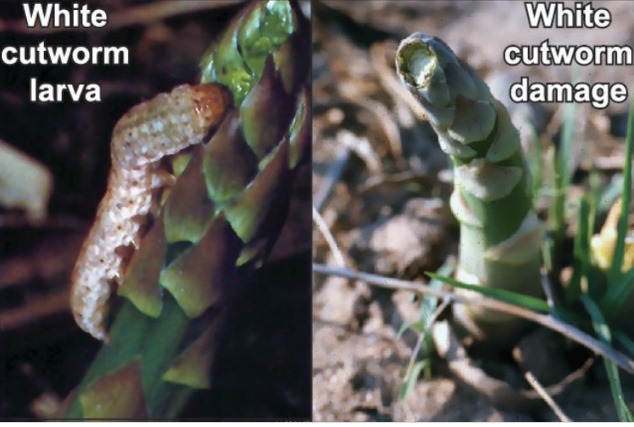
Permethrin is a common component of fern sprays. What do you do if you use up one of the allowed applications early on for cutworm? In the fern season, asparagus beetle, tarnished plant bug and Japanese beetle can be issues. Assail (acetamiprid) has activity against all three pests.
Cole crops and leafy greens
Cabbage and other brassicas and freeze-tolerant leafy greens have been planted since the beginning of April in the southern-tier counties of Michigan. Hoop house produced greens, including spinach, lettuce and chard have been going to market in some scenarios.
Cabbage white butterflies, also known as imported cabbage worm, are likely flying. Bt can be effective when caterpillars are small and conserves beneficials that help control other pests. Read more about using Bt from the University of Kentucky Cooperative Extension Service.
Cabbage maggot egglaying had ramped up with the warm weather at one west Michigan location this week with maggots present at some locations as well.
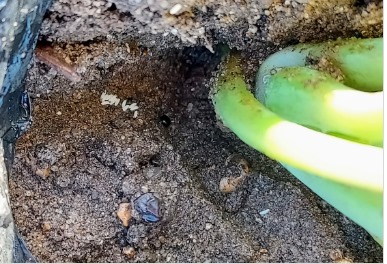
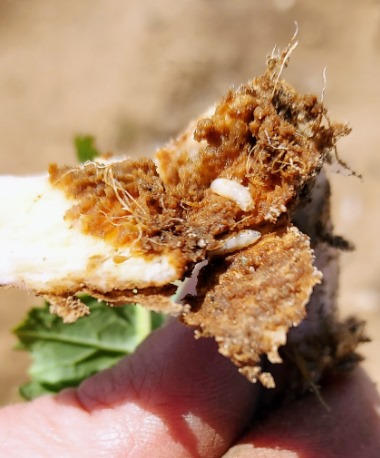
Scouting for eggs is a pain, so check out the cabbage maggot model on Enviroweather. It has a new look, aimed to make it easier to understand when management is critical. The model suggests fly emergence is under way at most locations, with peak flight still more than seven days away (but close).
For transplanted brassicas, tray drenches of Verimark have consistently provided protection against cabbage maggot. They also provide early protection against caterpillars and flea beetles. Tray drenches are to be made no sooner than 72 hours before transplanting. Verimark is labeled for in-furrow application in direct-sown brassicas like turnips and radishes, though efficacy has been variable across trials. Concentrating Verimark in the furrow is likely important; e.g., applying it as a liquid stream versus a band with a flat fan. This ensures a high concentration is present for developing roots to take up. The product is systemic, with no contact activity, so it needs to be in the root tissue when maggots take their first bite.
Diazinon is also labeled for radishes and rutabagas only. Row cover is highly effective as it excludes flies, keeping them from laying eggs on plants. Just make sure the ground did not have brassicas last summer/fall, otherwise there may be overwintering flies that emerge under the cover. Special purpose insect netting may allow for more air movement and be more durable than frost cloth, although both can work. Learn more about cabbage maggot control.
Cucurbits/pickles
Field work has started for the first pickle plantings. Fresh market summer squash and cucumbers are slated for transplanting and seeding on plastic next week in southwest Michigan. Growers in east Michigan have melons on the mind with plantings scheduled this week and onwards.
Fruiting vegetables
While tillage, fertilizer applications and plastic/drip-tape laying is still ongoing, some field tomatoes have been planted. Field plantings will increase throughout May, while tomatoes planted in unheated hoop houses have been planted since early April. Field plantings are slated to start next week for some growers in southwest Michigan. We received reports of thrips and also aphids in greenhouse crops, which can introduce viruses with confusing symptoms (see above).
Greenhouse tomatoes are at or near first harvest, and some of the common questions this time of year are about fruit set. Why don’t I have a good fruit set?
Temperature control has a lot to do with it. The environmental conditions in summertime lift all boats, so to speak. But the environmental conditions in February - May would leave tomatoes dead in the water without grower intervention. Management during this time has a big impact.
As reported in “Bumble bees for greenhouse production,” tomatoes and peppers need nighttime temperatures between 55-70 F to produce pollen, and daytime temperatures should not exceed 90 F. Flowers will abort completely after 4 hours over 100 F. Keeping hoophouse temperatures in that range through the dynamic temperature swings of spring is a challenge!
Pollination is of course another issue. In another article about bumble bees, we reported that excess pollination from a mismatch in bee population and flower density can result in the same flowers getting visited too much. In cases where bees are not being used, under-pollination can be an issue. Tomatoes are wind-pollinated, and so high tunnel tomatoes need daily disturbances to make sure the pollen drops. Opening sidewall vents is a great way to do this or shaking top-wire trellis strings or walking through with a leaf blower.
Another reason for poor or delayed fruit set is excess fertility from nitrogen. Nitrogen is a nutrient that pushes vegetative growth in plants, which also has an effect of delaying reproduction and fruit.
One final possibility, related to fertility, is switching to grafted plants. The rootstocks used for grafting are more efficient at utilizing nutrients and will often cause a delay in fruit set in the scions because of how much more growth they add to the plants. Grafted tomatoes need less fertilizer than ungrafted plants. In one hoophouse I visited a few years ago a whole row of grafted tomatoes blew over from excessive growth. In this particular case, they had been slowly pushing more N over the years to make up for poor growth from other soil stressors. So, the grafted plants hulked out taller than the rest before setting fruit, which may have contributed to their catching too much crosswind.
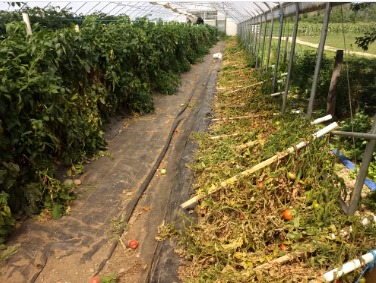
Potatoes
Planting has been underway on some farms in southwest Michigan. Planting has been happening in southeast Michigan since the beginning of April.
Onions and carrots
Growers were starting to terminate barley windbreaks in West Central this week. With the good weather and soil moisture, barley can grow quickly. Remember Goaltender can be applied at the one-leaf stage to help burn down small weeds and provide residual activity. This use is allowed in Michigan via a special local needs label.
Early sowings of carrots are already up—both for processing and direct-market sales—with more sowing continuing.
Sweet corn
Sweet corn planting is beginning to pick up in southeast Michigan. Seedlings have emerged from early plantings in the Bay Area.
Strawberries
Early sites where strawberries are being grown on plastic mulch are two weeks from harvest. Open fields are not as advanced with a few stray flowers just starting to open.
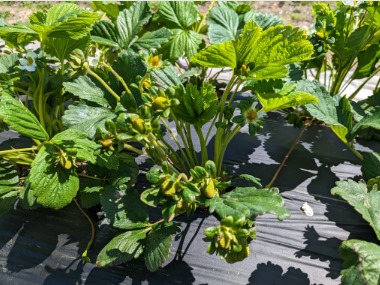
Source : msu.edu